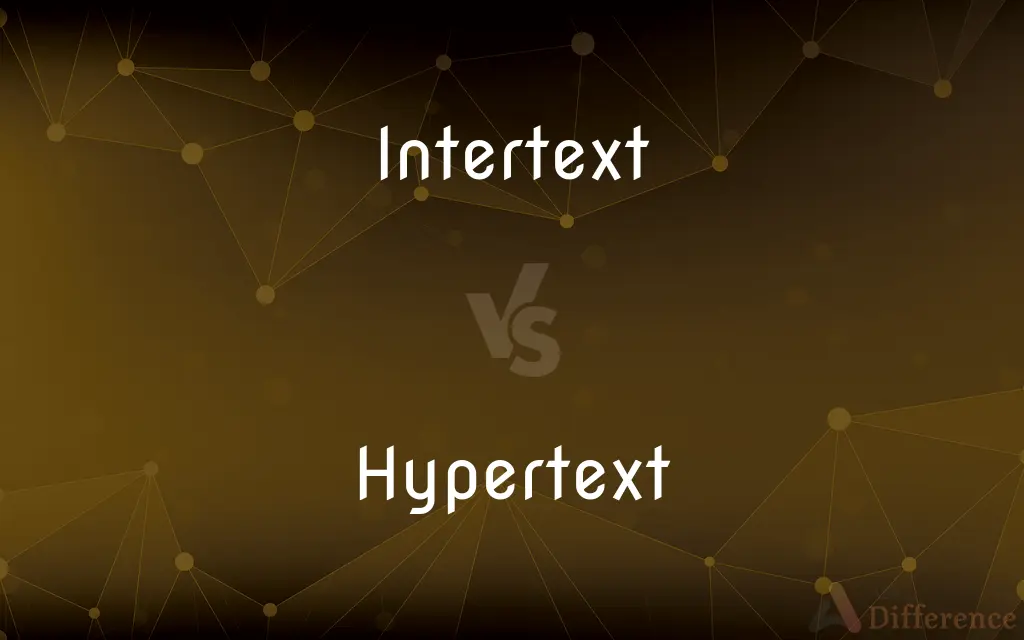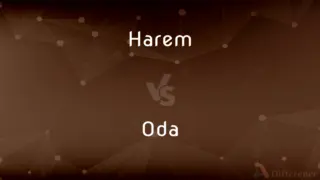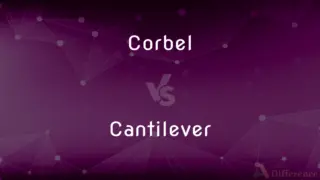Intertext vs. Hypertext — What's the Difference?
By Tayyaba Rehman & Fiza Rafique — Updated on April 3, 2024
Intertext refers to the relationship between texts and their references or influences, while hypertext is a digital text technology linking sections within or between documents.

Difference Between Intertext and Hypertext
Table of Contents
ADVERTISEMENT
Key Differences
Intertextuality highlights the relationship and referencing among texts, suggesting that texts influence each other through direct or indirect references. Whereas hypertext is a concept in digital text technology, allowing users to click and navigate between interconnected documents or sections within a document, making information retrieval dynamic and non-linear.
Intertext often involves the weaving of quotations, allusions, and forms from one text into another, creating a network of cultural references and meanings. On the other hand, hypertext relies on links (hyperlinks) embedded in digital texts that connect to additional information, be it within the same document or across the vast expanse of the internet, enhancing the reader’s experience by providing immediate access to related content.
While intertextuality is a critical and analytical concept used to understand the depth and breadth of literature and texts within cultural contexts, hypertext is a practical tool and format used in digital environments to organize, access, and navigate information more efficiently.
Intertextuality can be seen as a foundational aspect of literary theory, emphasizing the interconnectedness of literary works through time and culture. In contrast, hypertext represents a technological advancement in reading and writing, transforming how texts are created, shared, and engaged with in the digital age.
Despite their differences, both intertextuality and hypertext contribute to the complexity of text interpretation and interaction. Intertextuality enriches the reading experience by uncovering layers of meaning through textual relationships, while hypertext facilitates an interactive exploration of knowledge and information.
ADVERTISEMENT
Comparison Chart
Definition
The relationship and referencing among texts.
Digital text technology linking documents.
Purpose
To highlight influences and references between texts.
To navigate between interconnected documents.
Usage
Literary analysis and cultural studies.
Digital environments, websites, and documents.
Nature
Conceptual and analytical.
Practical and technological.
Reader's Role
Interpret and uncover layers of meaning.
Navigate and explore linked information.
Compare with Definitions
Intertext
The interplay of texts across cultural and historical contexts.
A poem that alludes to historical events ties itself to the broader narrative of those events through intertextuality.
Hypertext
A system for organizing and linking digital documents.
Websites use hypertext to link to related pages, facilitating easy navigation.
Intertext
The embedding of older texts in new ones to create depth.
Modern novels might echo themes from Biblical stories, engaging in intertext.
Hypertext
A digital framework for interconnected documents.
E-books may use hypertext to link chapters, glossaries, and references.
Intertext
A critical tool for analyzing the dialogue between texts over time.
Scholars examine the intertextuality between Renaissance literature and its classical influences.
Hypertext
Technology enabling non-linear access to information.
Online encyclopedias employ hypertext to connect articles through links.
Intertext
A method of citing influences and connections between literary works.
Shakespeare’s plays often reference classical myths, illustrating intertextuality.
Hypertext
A method for enhancing digital texts with links.
Blogs use hypertext to direct readers to related posts or external websites.
Intertext
The practice of integrating text references to enrich narratives.
A novel might include quotes from other literary works to deepen its themes, demonstrating intertextuality.
Hypertext
The backbone of web navigation and information architecture.
Hypertext allows users to jump between information sources on the internet seamlessly.
Intertext
A reference to one text within another.
Hypertext
Hypertext is text displayed on a computer display or other electronic devices with references (hyperlinks) to other text that the reader can immediately access. Hypertext documents are interconnected by hyperlinks, which are typically activated by a mouse click, keypress set, or screen touch.
Hypertext
Digital text that contains hyperlinks to other texts.
Hypertext
(uncountable) Digital text in which the reader may navigate related information through embedded hyperlinks.
Hypertext
(countable) A hypertext document.
Hypertext
Machine-readable text that is not sequential but is organized so that related items of information are connected;
Let me introduce the word hypertext to mean a body of written or pictorial material interconnected in such a complex way that it could not conveniently be presented or represented on paper
Common Curiosities
How does intertextuality affect the reading experience?
Intertextuality enriches the reading experience by adding layers of meaning through references to other texts.
What is intertext?
Intertext refers to the way texts reference, influence, and relate to one another within literature.
Is hypertext limited to the internet?
No, hypertext is not limited to the internet; it also applies to any digital or electronic document system that uses links.
How does hypertext work?
Hypertext works by using hyperlinks embedded in digital texts to link to other documents or sections, allowing for non-linear navigation.
What makes hypertext unique compared to traditional text?
Hypertext is unique due to its ability to facilitate interactive and non-linear navigation through linked digital documents.
How does intertextuality contribute to cultural understanding?
Intertextuality contributes to cultural understanding by revealing how texts are interconnected across times and cultures.
Are hyperlinks the only feature of hypertext?
While hyperlinks are central to hypertext, features also include multimedia integration and interactive elements.
What are the benefits of hypertext in education?
Hypertext offers dynamic learning opportunities by enabling students to explore interconnected information easily.
Can intertextuality be unintentional?
Yes, authors may unconsciously incorporate elements from other texts, creating unintentional intertextuality.
Can intertextuality exist in hypertext?
Yes, intertextuality can exist in hypertext when digital documents reference or allude to other texts, blending the concepts.
Can any text be considered intertextual?
Theoretically, any text can be considered intertextual if it references, alludes to, or is influenced by other texts.
How has hypertext changed the way we read?
Hypertext has changed reading by introducing interactive and non-linear paths through information, enhancing engagement.
What role does intertextuality play in literary analysis?
Intertextuality is crucial in literary analysis for understanding the depth of texts and their relationships within the literary canon.
How does hypertext affect web design?
Hypertext affects web design by necessitating structures that support easy navigation and information access through links.
Can hypertext exist outside of digital texts?
While primarily associated with digital texts, the concept of hypertext can inspire non-digital works that mimic its structure of interconnectedness, though it’s fundamentally a digital technology.
Share Your Discovery

Previous Comparison
Harem vs. Oda
Next Comparison
Corbel vs. CantileverAuthor Spotlight
Written by
Tayyaba RehmanTayyaba Rehman is a distinguished writer, currently serving as a primary contributor to askdifference.com. As a researcher in semantics and etymology, Tayyaba's passion for the complexity of languages and their distinctions has found a perfect home on the platform. Tayyaba delves into the intricacies of language, distinguishing between commonly confused words and phrases, thereby providing clarity for readers worldwide.
Co-written by
Fiza RafiqueFiza Rafique is a skilled content writer at AskDifference.com, where she meticulously refines and enhances written pieces. Drawing from her vast editorial expertise, Fiza ensures clarity, accuracy, and precision in every article. Passionate about language, she continually seeks to elevate the quality of content for readers worldwide.
















































